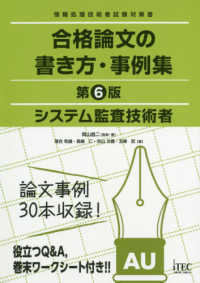- ホーム
- > 洋書
- > 英文書
- > Science / Mathematics
基本説明
A graduate-level introduction.
Full Description
Differential geometry began as the study of curves and surfaces using the methods of calculus. In time, the notions of curve and surface were generalized along with associated notions such as length, volume, and curvature. At the same time the topic has become closely allied with developments in topology. The basic object is a smooth manifold, to which some extra structure has been attached, such as a Riemannian metric, a symplectic form, a distinguished group of symmetries, or a connection on the tangent bundle. This book is a graduate-level introduction to the tools and structures of modern differential geometry. Included are the topics usually found in a course on differentiable manifolds, such as vector bundles, tensors, differential forms, de Rham cohomology, the Frobenius theorem and basic Lie group theory. The book also contains material on the general theory of connections on vector bundles and an in-depth chapter on semi-Riemannian geometry that covers basic material about Riemannian manifolds and Lorentz manifolds. An unusual feature of the book is the inclusion of an early chapter on the differential geometry of hyper-surfaces in Euclidean space. There is also a section that derives the exterior calculus version of Maxwell's equations. The first chapters of the book are suitable for a one-semester course on manifolds. There is more than enough material for a year-long course on manifolds and geometry.
Contents
Preface
Differentiable manifolds
The tangent structure
Immersion and submersion
Curves and hypersurfaces in Euclidean space
Lie groups
Fiber bundles
Tensors
Differential forms
Integration and Stokes' theorem
De Rham cohomology
Distributions and Frobenius' theorem
Connections and covariant derivatives
Riemannian and semi-Riemannian geometry
The language of category theory
Topology
Some calculus theorems
Modules and multilinearity
Bibliography
Index
-

- 和書
- 大相撲












